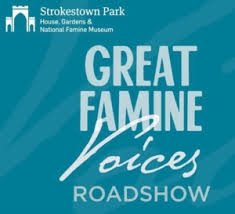The Great Famine Voices Roadhow accompanied Lynn Rogers, of Friends of Abandoned Cemeteries, on board the Staten Island Ferry to visit these Famine Irish burial grounds of which she is a custodian.
Despite the upward mobility and political impact of the Famine Irish in New York, many perished in the Staten Island quarantine hospital shortly after their arrival in 1847 and 1848.
One of the most powerful video testimonies during the Great Famine Voices Roadshow at Glucksman Ireland House came from Jennifer Robinson, who lives in Hanover, Pennsylvania. Jennifer notes that she is descended from Edward Neary, a Famine emigrant from Elphin in County Roscommon who fled from Ireland in 1847. She recollects how family stories have been passed down of Edward Neary’s father and siblings being stricken with typhus in the fever sheds of Montreal, leaving him an orphan in Canada and then the United States.
In her own words: “My mom was the big researcher in our family. She wrote a simple grandchildrens’ story about the voyage of the Neary family in 1847 coming to the United States. We read it every year at Thanksgiving. I think that it would be important for Edward Neary to know, and for the Nearys to know, that we still think about them and what they went through, and what they left behind. I hope that my family gets to go see Ireland, because we have roots there, and our blood is there. We have people there who are our family and who are buried there. So I am looking forward to seeing Ireland very soon.” Shortly thereafter, Jennifer decided to make her first visit to Ireland with her daughter to attend the Irish Famine Summer School at Strokestown Park.
The story of Jennifer Robinson’s ancestor Edward Neary read every year at Thanksgiving can be found at this link.
Great Famine Voices Roadshow New York Launch: American Irish Historical Society
Great Famine Voices Roadshow New York Gallery
Great Famine Voices Roadshow Philadelphia
The Great Famine Voices Roadshow was welcomed to the Parkway Central Library of Philadelphia by Adam Leo Feldman, Library Coordinator of the Central Library.
Adam Feldman also shared his own family stories of his Jewish and Irish ancestry and upbringing in Philadelphia. In his own words: The Irish Famine story connects with the stories of so many immigrants and migrants to Philadelphia, since foundation to contemporary days as we integrate new refugees into Philadelphia.
I think that one of the messages from the Great Famine Voices Roadshow in Philadelphia that I was very pleased to see come out was that many institutions in the United States built by the Irish, such as the contemporary Irish Immigration Center, serves not only Irish émigrés who have come in the past generation or two, but also Philadelphia’s enormously large group of immigrants from every continent. It is nice to see memory serve as a reminder to do what is right.
The Great Famine Voices Roadshow also met with Nicola Bell from the Irish Immigration Center in Philadelphia.
The Irish in Philadelphia, Then and Now
As Nicola Bell explained: We see other people at the clinic who are not necessarily Irish. They can come from certain Latino countries in south and central America, and often their conditions are very different. You can almost say that it is like a parallel that is somewhat similar to why Irish Famine victims were fleeing Ireland. They want safety for their families. Hence they come here. The same you could say for parts of Mexico and the like where people are fleeing extreme poverty. They will do whatever it takes, like what the Famine victims did, to preserve their families and their own lives, and try and create a better future for themselves.
